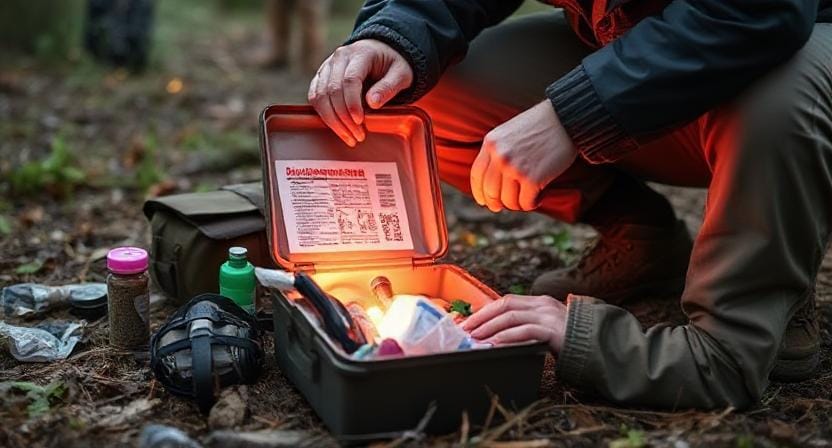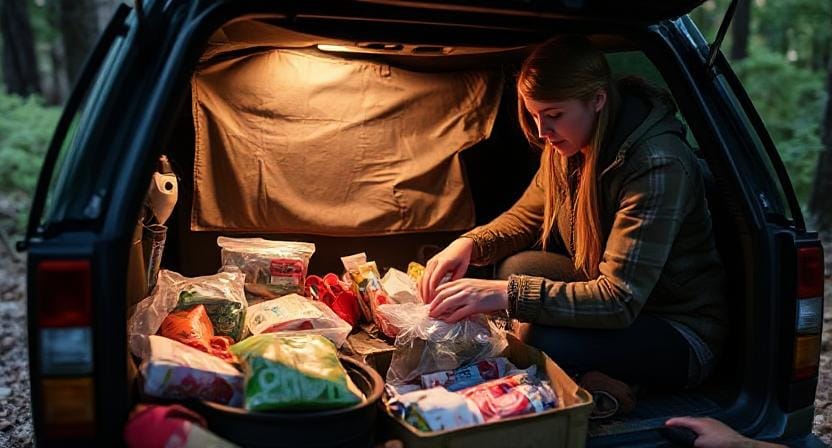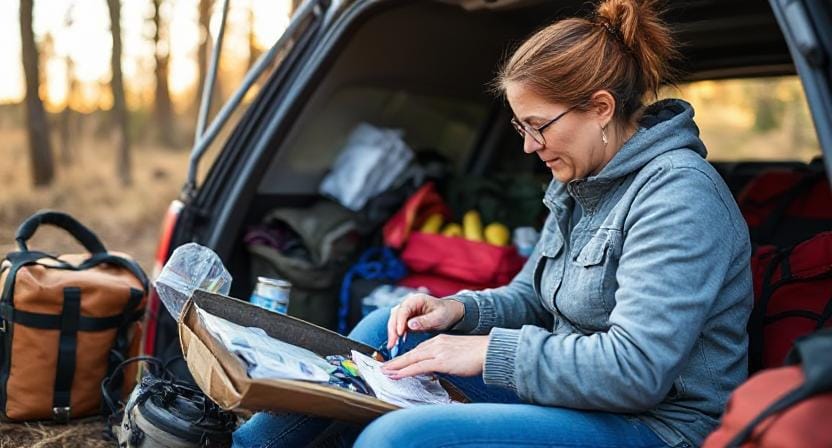Please Note: This post may contain affiliate links. If you click one of them, we may receive a commission at no extra cost to you. As an Amazon Associate, I earn from qualifying purchases.
Top Takeaways and Key Concepts
- Store at least one gallon of water per person per day for emergencies.
- Keep long-lasting food like canned goods and energy bars ready to eat.
- Include a stocked first aid kit to handle minor injuries quickly.
- Pack light sources and power backups like flashlights and batteries.
- Customize and update your kit regularly to match family needs.
Summary of This Article
This article explains why every household should have a reliable emergency kit and what essentials to include. It covers preparing for unexpected events like storms, power outages, or disasters by storing water, non-perishable food, a first aid kit, batteries, and a multi-tool. It also stresses personalizing your kit with items like medications, pet supplies, or baby care essentials. Finally, it reminds readers to maintain and refresh the kit regularly so it stays ready when disaster strikes. Being prepared builds confidence and safety for the whole family.
Short Video Version of this Article
Imagine this: a storm hits out of nowhere. The lights go out, and you’re in your living room with a flashlight that’s starting to flicker. Yikes! What do you reach for?
If you find yourself digging through a messy drawer, we definitely need to chat. An emergency kit? It’s not just a fancy thing. It’s really, really important. Having one can make a big difference when life throws surprises your way.

Think about it. Water is a must. You need a few bottles, just in case. Snacks are great too. Grab some protein bars or nuts. They’re easy to store and can keep you going when you can’t cook.
Don’t forget a first aid kit! Band-aids, antiseptic wipes, maybe some pain relievers. Just a few basics can help you feel less stressed if someone gets a little bump.
And batteries. Lots of batteries. For your flashlight, radio, anything that needs power. You want to be sure you can see and hear what’s going on outside. Candles are another good idea. Just remember to keep them safe. We don’t want any accidents.
Add a charger for your phone. Imagine losing your phone’s battery. That’d be a headache! A portable charger can save the day.
A little backup plan goes a long way. Keep everything in a bag or a box that’s easy to find. Grab it and go, if you need to.
When you’re feeling prepared, it makes everything less scary. Knowing you have what you need? That can change a panic moment into a manageable one. So, having an emergency kit? Totally worth it. When you plan ahead, you gain peace of mind. And that’s what we all want, right?
Why You Need an Emergency Kit

First of all, why should you even think about getting an emergency kit? Life is full with surprises. Hurricanes, earthquakes, and floods are all examples of natural disasters that can happen without warning.
If you’re not ready, even small situations like a broken pipe or a power outage might put you in a panic. If you have an emergency kit, you’re ready for anything that comes your way.
In a way, it’s like having insurance. You don’t get automobile insurance because you want to get into accidents; you do it because they happen and you want to be protected when they do. An emergency pack also gives you piece of mind because you know you have everything you need.
Imagine if a snowstorm comes out of nowhere. You can’t leave your house, and it’s cold. No food. No warmth. Not at all fun, right?
You won’t experience that panic if you have a good emergency pack. While everyone else is out there battling for bread and milk, you can stay safe and warm inside. What is going on with the rush for bread and milk?
Getting your things ready ahead of time will save you a lot of time and frustration. You won’t have to run around town at the last minute looking for batteries or a flashlight because everything is already in your kit. Everything is just waiting for you. How nice is that?
Give it some thought. You may bring snacks, blankets, and maybe even a game or two to pass the time. It makes being locked inside feel less threatening and more like an adventure.
Are you making a pack for emergencies at home? It’s smart. Knowing you have what you need is a pleasant feeling. It changes that worried emotion into one of confidence. You are in responsibility of keeping your family safe and sound. That’s empowering! Think about how good it will feel to know you planned beforehand. Doesn’t it make you feel like a superhero?
Essential Items Every Kit Should Have

Okay then! Let’s get right to the point of this magical box of preparedness: the things that every home should have in its emergency kit.
1. Water:
Let’s chat about H2O. It’s very crucial. You can’t go without it for very long, can you? Try to drink one gallon of water every day. That’s for three days. It sounds like a lot, but it adds up quickly!
And don’t forget about your pets! Like us, they require water. It’s a big problem if they’re thirsty. Who wants a sad cat or dog?
When you pack, remember that water might be weighty. It helps to find containers that are easy to handle. You can use huge bottles or even empty juice containers. Just make sure they’re clean.
Everyone is happy and healthy when they drink enough water. Having extra water can make things a little simpler in an emergency. You can think more clearly now. You won’t be as worried.
Think about it. You have enough drinkable water, so you can focus on other things. That’s a good deal for both sides! It’s a tiny step, but it makes a great difference when things get hard. And hey, it’s always nice to be ready!
2. Non-Perishable Food:
Let’s talk about food. The kind that stays fresh for a long time and doesn’t go bad quickly. Canned foods are awesome! Just get some soup, beans, or vegetables. And don’t forget the can opener. That’s important! No one likes to be stuck looking at a can they can’t open.
Energy bars are great too. They taste great and are really useful. You can merely take one when you’re hungry. Raisins and apricots are two examples of dried fruits that make terrific snacks. They’re chewy and sweet, which makes them great for a rapid boost.
Think about it. You want food that is easy to make and eat. When things are tough, you don’t have to cook. You can snack on them as you make plans or just relax.
Having these things on hand can help you relax. You won’t have to worry about what to eat. Everything is there, ready for you to eat. And if it’s snowing outside, it feels good to curl up with some munchies, right?
Having tasty meals ready makes you feel more at ease. You know you can deal with everything that comes your way. That feels fantastic!
3. First Aid Supplies:
Oh, let’s talk about first aid kits. This one’s super important! You never know when a little accident might happen. You could trip, stub your toe, or get a cut.
Band-aids are a must-have. Kids love them, right? They make everything feel better. Antiseptic wipes are great too. They help clean up scrapes. Nothing worse than dirt mixing with a cut.
Gauze pads are good for bigger boo-boos. They help stop bleeding. You want those handy. And let’s not forget pain relievers. They really help when you’ve got a headache or sore muscles. Trust me, it’s so nice to have relief when you need it.
Check your kit now and then. Make sure everything’s in there and hasn’t expired. You don’t want to open it and find old stuff, yuck!
Feeling ready with a well-stocked kit gives you peace of mind. You can handle little emergencies way better. Knowing you’ve got what you need? That’s a cozy feeling. Real comforting, right?
4. Flashlights and Batteries:
Oh man, blackouts can be so annoying. You’re just sitting there, and then—bam! Darkness everywhere. Flashlights really are lifesavers in these moments. There’s something comforting about having a little light when everything else is dark.
It’s not just about having a flashlight, though. Gotta think about extra batteries too. Seriously, what good is a flashlight if it won’t turn on? You don’t want to be fumbling around in the dark, hoping it has enough juice.
Maybe stash a few in different places. One in the kitchen, another in the living room. Ooh—how about one in your bedroom? You never know when you might need it.
If you’ve got kids, let them pick their own flashlight. They love that! Makes them feel calm too.
Having extra batteries means you can shine your light as long as you need. That’s such a relief. You’ll feel more prepared, and that cheers you up, right? Being ready for the unexpected is nice. It brings peace of mind.
5. Multi-tool or Swiss Army Knife:
You know those little multitool gadgets? They’re pretty much mini superheroes. Seriously! One minute you need to open a box, the next you’re tightening a screw. It’s wild. You’ll really appreciate having one around when something breaks suddenly.
Imagine this: a loose screw on your favorite chair or a package that just won’t open. Just whip out that handy tool, and boom! Problem solved.
Now, let’s talk hygiene. Nothing’s worse than feeling gross when things get chaotic. Packing some wet wipes is such a good idea. They’re perfect for quick clean-ups. You spill something? Wipe it up! Got sticky hands? Bam! Freshness!
Hand sanitizer is also a must-have. You can’t always wash your hands, especially in a pinch. Just a squirt and you feel like a whole new person.
Keeping clean helps clear your mind too. You feel more ready to tackle whatever comes your way. It’s like a little boost of confidence during those unexpected moments. So, toss those goodies in your emergency kit. You’ll be so glad you did!
Personalizing Your Kit

Now that we’ve gone over the essentials, let’s talk about how to make your emergency pack fit the needs of your family. Everyone’s scenario is different, so be sure you have everything you need when calamity hits!
For families with little children or babies? Think about getting diapers and baby formula if you need them. Do you have pets? Don’t forget to bring them food and any meds they might need on a regular basis!
It’s also important to include any prescriptions and paperwork about any chronic illnesses or allergies that someone in your household has in case they require help later on.
Let’s chat about technology. Portable chargers are a game-changer for people who can’t stop looking at their phones or tablets. Think about what would happen if the power went out and you needed to get in touch with someone. Do you have a way to keep your phone charged? Very brilliant, huh?
When things go wrong, a backup battery bank is like your best buddy. When you genuinely need aid, you don’t want to be closed off from the world. It makes you feel a lot safer, like having a safety net.
If you have hobbies like crafting or camping, you should put some of your basic supplies in your emergency kit. You know, like your beloved fishing pole, some glue, or scissors. When things are a little crazy, it can really help to keep your spirits up.
Being able to do your hobbies or manufacture things can help you get through a challenging moment. When everything else is a little stressful, it’s wonderful to have something familiar to focus on. So go ahead and put away the tools that make you happy. Later, you’ll be glad you did!
Maintenance and Updates

Building an ultimate home emergency kit isn’t just set-it-and-forget-it work; regular maintenance ensures everything stays fresh and functional over time!
Start by checking expiration dates on food items every six months (yes—that includes those granola bars!). Rotate older supplies out while replacing them with new ones so nothing gets wasted—or worse yet—becomes unusable right when you need it most!
Additionally—and I’m serious here—it helps immensely if someone else knows where this treasure trove resides within your house! Create clear labeling systems if necessary so family members aren’t playing hide-and-seek looking for essential items during crises.
You know what’s cool? Having a little organization magic in your life. It’s great to have an emergency kit ready, but using it together can be a game-changer. Imagine everyone knowing exactly where the flashlight is when the lights go out. It’s way less stressful.
Practicing with the kit helps everyone feel calm when things go sideways. It’s like a little drill for when life throws us a curveball. You want to grab that first aid kit without frantically looking all over, right? When you know where everything is, emergencies seem less scary.
Building your ultimate home emergency kit is empowering! You get to pick things that matter most to you and your family. Maybe it’s snacks that your kids love or a special toy for comfort. You’re making sure everyone is taken care of when surprises come knocking (or crashing).
Gather those supplies, don’t wait! Tomorrow might bring some unexpected twists, but with a bit of prep, you’ll be ready. It’s like having a superhero cape, right? You’ll handle whatever comes your way. Just think about how nice it’ll feel to be prepared.
Building a home emergency kit ensures your family is prepared for power outages, storms, and disasters. A good kit includes water, food, first aid, lighting, and tools. Personal items like medications and pet supplies make it more useful. Regular updates keep it reliable when emergencies strike.
Frequently Asked Questions
What is the most important item to include in an emergency kit?
Water is the top priority. Store at least one gallon per person per day for a minimum of three days to cover drinking and basic hygiene needs.
How long can emergency food last in a kit?
Non-perishable foods like canned goods, energy bars, and dried fruits can last months to years if stored in a cool, dry place and checked regularly.
Why do I need a first aid kit in an emergency pack?
A first aid kit helps treat minor injuries such as cuts, burns, and sprains, preventing small wounds from becoming serious when medical help is unavailable.
What type of light sources should I pack?
Include flashlights with extra batteries and consider backup options like headlamps or glow sticks for safe lighting during power outages.
How do I personalize an emergency kit for my family?
Add prescription medications, baby supplies, pet food, and any personal comfort items your family may need during an emergency.
Where should I store my emergency kit?
Store your kit in an easy-to-access location known by every household member, such as a hall closet or near an exit for quick evacuation.
How often should I update my emergency kit?
Review and refresh your kit every six months by replacing expired food, water, medications, and used supplies to keep it ready.
Suggested External Resources:
Emergency Preparedness Guide
https://www.ready.gov/plan
How To Build An Emergency Kit
https://www.redcross.org/get-help/how-to-prepare-for-emergencies/survival-kit-supplies.html
The Importance Of Being Prepared
https://www.fema.gov/emergency-management/preparedness

Kevin Collier is a seasoned outdoor enthusiast and writer for Trekbug.com, specializing in outdoor adventures, survival strategies, and prepping insights. With a deep love for nature and a commitment to self-sufficiency, Kevin empowers readers to embrace the wilderness confidently. He shares valuable tips, practical techniques, and inspiring stories, helping both novice and experienced adventurers develop essential skills for surviving and thriving in the great outdoors.





